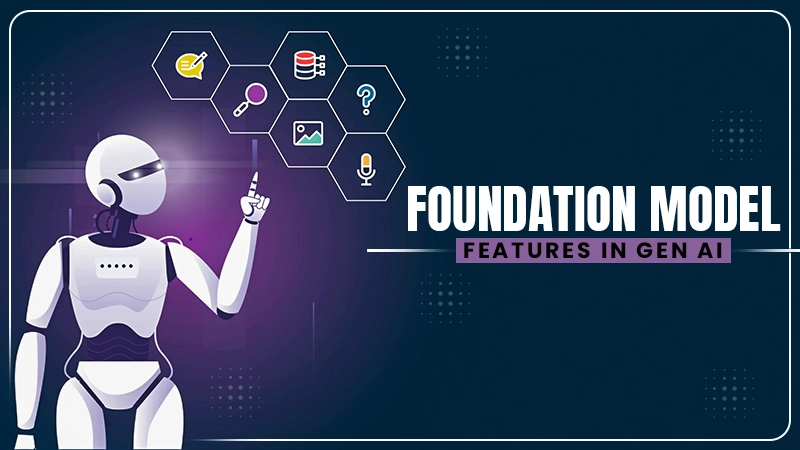Foundation Models in Generative AI: Key Features and Real-World Use Cases

Have you ever wondered how AI can create art and stories and solve complicated problems? Foundation Models are the brains and engines of AI that are responsible for all this magic. Previously, generative AI models were developed to perform specific tasks such as writing literature, recognizing photos, etc. This approach was effective but wasn’t the best for using AI to its maximum capacity. Every new assignment seemed like starting over.
Imagine having multiple tools for every minor job. Sounds like too much hassle, right? However, with Foundation Models, that issue is a thing of the past. These models are huge, adaptable, and can learn many skills. Once trained, they can be customized without starting over. It’s as if you have a very intelligent system that can adjust to various requirements, enhancing the efficiency and adaptability of AI to incredible levels. Are you prepared to delve into the ways these models are opening up fresh opportunities in generative AI? All right, let’s explore!
Defining Foundation Models
Foundation models are generative AI’s “big brains.” They’re pre-trained on massive data sets, making them versatile starting points for various AI tasks. Imagine a foundation model as an AI that has learned many patterns, language structures, and visual signals from the internet’s massive datasets. These models are ready to be customized as they can understand language, visuals, and sound because of pre-training.
What’s cool about foundation models is their adaptability. Pre-trained models don’t have to start over each time they’re assigned new tasks. Instead, they can be customized for specific tasks such as generating customer service responses, translating languages, or creating realistic visuals. Foundation models in AI act as a foundational layer on which more customized applications can be developed, saving time and money and unlocking astonishing capabilities.
Key Features of Foundation Models
Foundation models have become the backbone of modern AI due to their incredible versatility, scale, and adaptability. These models are equipped with vital qualities that make them powerful and effective in many applications. They aim to expand AI’s capabilities by managing large datasets, analyzing many forms of data, and performing exceptionally well in a variety of tasks. Let’s break down key features that make foundation models stand out.
1. Scale and Processing Capacity
Foundation models are designed to handle large-scale operations. Envision training a model on online data from news stories, scientific publications, social media messages, and more. That’s the kind of scaling we’re talking about. These models are trained on massive datasets with billions of parameters to capture complex details and correlations within the data.
Foundation models need massive computational resources to handle vast data. Employing high-performance GPUs and TPUs helps these models process and learn from this data. Foundation models can address complicated, high-level tasks like language translation, image recognition, and advanced scientific research due to their huge processing capability. Since foundation models can function on such a wide scale, they are powerful and can solve problems that traditional AI approaches cannot.
2. Multimodal Input Capability
Multimodal input capabilities are one of the foundation models’ most fascinating characteristics. Imagine a model that can comprehend text, photos, videos, and audio. That is the capability of foundation models. This capacity provides unlimited possibilities in content development, VR, and robotics.
For example, consider an AI that can generate images or videos from text descriptions. Or think about virtual assistants who can smoothly analyze what you have spoken or comprehend your gestures. This kind of multimodal processing helps these models perceive context more deeply. Foundation models are useful in fields such as entertainment, healthcare, and education, where multiple forms of information intersect. This is because these models are capable of bringing together different data types to solve complex problems.
3. Task Generalization
Another superpower of the foundation model is its capacity to generalize knowledge across tasks. Foundation models can adapt to many applications, even those they weren’t planned for, unlike traditional models. Consider them as multitools: one model that can efficiently generate text and recognize images. This task generalization originates from the model’s exposure to diverse training data. It recognizes patterns across domains and applies them to new tasks without starting over. For instance, a linguistic data model can be fine-tuned to summarize text or answer document inquiries without additional training. This versatility makes foundation models very efficient and cost-effective. They speed up and scale AI development by eliminating the need to train models for each new application.
4. Self-Supervised Learning
Self-supervised learning is the foundation models’ secret weapon. These models use raw, unlabeled data instead of expensive, time-consuming annotated data(it is costly and time-consuming). They teach themselves by predicting data, such as filling in sentence blanks or interpreting image context.
This strategy greatly eliminates human interaction during training, making foundation models more scalable and customizable. Further, the models can handle new applications better since they can learn from more data sources without labeling. Self-supervised learning enables foundation models to swiftly adjust to text, image, and video input. This adaptability makes foundation models useful for finance and healthcare.
Use Cases of Foundation Models
Foundation models have transformed generative AI by enabling its industry-wide applications. Their ability to understand and generate text, graphics, video, and speech makes them versatile. A leading generative AI development company employs these models to build intuitive, efficient, and scalable AI systems. Foundation models make AI more versatile and accessible for language translation, customer support, and content development. Let’s look at some of their real-world applications.
1. Language Translation and Summarization
Our ability to communicate across languages has been evolved by foundation models. For example, consider real-time language translation. Models like GPT and BERT are trained on vast multilingual datasets to translate text accurately in real-time. Foundation models make language obstacles easy to overcome when traveling or doing business abroad.
Document summarization is another useful application besides translation. With so much information available nowadays, reading long documents can be overwhelming. Foundation models save time and effort by summarizing extensive documents into key points. This is beneficial for legal, research, and media, where professionals must distill large amounts of data.
2. Image and Video Generation
Foundation models are also effective in the area of creative content development. AI can now create realistic images and movies for marketing, entertainment, and education using these models. Consider models like DALL·E or Midjourney, which can generate high-quality graphics from text descriptions. This helps brands create visual content on demand, saving time and money on design.
Foundation models create a path for AI-generated animations and deepfake technology, which can make realistic videos by giving input as prompts. Despite ethical worries about deepfakes, video production has huge recreational possibilities and benefits the education sector. Imagine students interacting with AI-generated historical figures or brands, making advertising videos in minutes.
3. Automated Customer Support with Conversational Agents
Foundation models have brought customer assistance into a new age. Traditional chatbots struggled to grasp complex questions and offer useful responses. Now, advanced models like ChatGPT make virtual assistants and conversational agents smarter, more engaging, and human-like.
These AI-driven chatbots can fix technical issues, answer product questions, and provide personalized suggestions. Customer service is more fluid with foundation models because they comprehend language context and nuances. Businesses can now offer 24/7 help without compromising quality, enhancing customer satisfaction and lowering operational expenses.
4. Sentiment Analysis for Social Media Monitoring
Social media is a goldmine for insights into public opinion and sentiment. By evaluating social media content in real-time, foundation models enable corporations to access this resource. These models analyze massive volumes of text data from Twitter and Facebook to determine popular opinions on subjects, products, and trends.
This is helpful for brands who want to know how their customers feel about their products or advertisements. Using foundation models for sentiment analysis, businesses can quickly adjust their plans, discover shortcomings, and better meet client needs. This form of social media monitoring is becoming an increasingly important part of marketing, public relations, and customer interaction strategies.
Conclusion
To put it simply, generative AI relies on foundation models. They are like multi-talented artists who can develop text, photos, music, and more by learning from massive data sets. Consider them a toolset that AI uses to create stories and paintings. These models learn patterns and relationships in the data they’re trained on and can execute a wide range of tasks, often surprising us with their creativity. Foundation models enable AI bot chats, artwork creation, and complicated problem-solving, paving the way for AI-driven creativity. So, next time you’re amazed by AI’s abilities, remember that foundation models power the magic!



